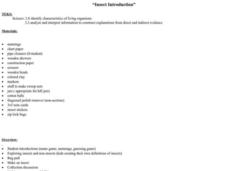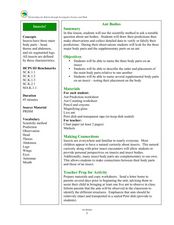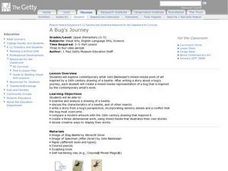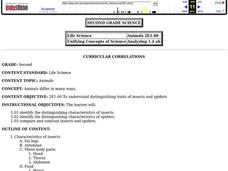Curated OER
Those Busy, Buzz'n Worker Bees
Students research information on worker bees. In this insect lesson, students review the body parts of insects and how bees find flowers. They discuss compound and simple eyes and the life cycle of a worker bee.
Curated OER
Create Your Own Insect
In insect worksheet, students read the facts about insects. Students then use the insects and create their own insect including all the body parts listed.
Curated OER
Parts of an Insect
In this online interactive parts of an insect activity, students respond to 12 multiple choice questions regarding the information included in the provided paragraphs.
Curated OER
Interesting Insects
Students discover the characteristics of insects. They explore insects through cooperative learning, group projects, hands on activities, and poetry. They gain knowledge of insect life cycles, habitat, and physical characteristics.
Curated OER
Insect Anatomy
In this insect anatomy worksheet, students utilize a word bank to label the six parts of an insect: abdomen, antennae, head, legs, thorax and wings.
Curated OER
Word Unscramble: Insects
In this insect word scramble, students try to decipher 15 insect words. There is no word bank in this word scramble puzzle. All words are insect names.
Curated OER
A Bugs Life: Diary of an Insect's Metamorphosis
Students play games to learn about the life stages and metamorphosis of different insects. In this insects lesson plan, students discuss the life of insects, and then play matching, vocabulary, and memory games.
Curated OER
Parts of an Insect
In this science learning exercise, students read about the three parts of an insect. Students also analyze a labeled picture of an insect that shows its mouth, antenna, head, led, thorax, and abdomen.
Curated OER
The Young Virginia Gardener: Garden Pests and Problems-Insects
In this garden pests and problems worksheet, students read about insects and research what insects use their antenna for, comparing 2 or 3 different types.
Curated OER
Is it an Insect?
Students identify insects based on their characteristics. In this insect characteristics lesson, students study the 3 images of the millipede, housefly, and woodhouse insect. Students complete the insect characteristic chart.
Curated OER
Activity Plan 5-6: Bugs, Bugs, Bugs!
Young scholars become entomologists for a day. In this life science lesson, students go on an insect hunt and investigate insects and their homes. This leads to the creation of an insect by each student. Lesson includes a take-home...
Curated OER
Termite Biology
Students explore the physical characteristics, distribution and habitat of termites. The lesson focuses on the termite as a social creature contrary to most other insects.
Curated OER
Insect Introduction
Second graders investigate insects and non-insects by creating their own definitions. They complete a series of activities relating to insects.
Curated OER
Ant Bodies
Students name the three parts that comprise an insect body. In this ant lesson plan, students make connections regarding the curiosity of insects as it touches upon the students' personal perspectives. Students then observe ants in class...
Curated OER
Arthropod Coloring
In this arthropod worksheet, students compare and contrast the different animals found in the Phylum Arthropoda: insects, arachnids, and crustaceans. Students complete 8 fill in the blank statements and color illustrations.
Curated OER
Arthropods, Insects, Arachnids, and Crustaceans
In this biology worksheet, students read about arthropods and some of the different species that fit into this classification. They then answer 13 questions about what they just learned. The answers are on the last page of the packet.
Curated OER
A Bug's Journey
Students examine the artwork of John Baldessari that was inspired by a 16th century drawing of a beetle. They analyze a drawing of a beetle, discuss the insect's characteristics, and write a story from the perspective of a bug. Also,...
Curated OER
Bees and Wasps
In this biology activity, students look for the details that are common to the insects. Then they label the parts for the two diagrams.
Curated OER
Diversity of Arthropods
For this arthropods worksheet, students will review the characteristics of the different types of arthropods including spiders, ticks, crustaceans, millipedes, and insects. Students will also understand the difference between complete...
Curated OER
Insects: Grasshoppers
Students examine grasshoppers as they practice following instructions. In this biology lesson plan, students identify the characteristics of grasshoppers and the functions of grasshoppers' external body parts.
Curated OER
Animals
Second graders explore the ways in which animals differ. They discuss the characteristics of insects and spiders. Students identify the characteristics of insects and spiders. They compare and contrast insects and spiders.
Curated OER
Arthropod Coloring Worksheet
In this biology worksheet, learners color and label the different parts of arthropods. They complete 63 short answer and fill in the blank questions on arthropods.
Curated OER
Arthropod Rhymes
In this arthropods worksheet, students read rhymes about arthropods and use the science terms they have learned to answer the question following the rhyme. This worksheet has 12 fill in the blank questions.

























